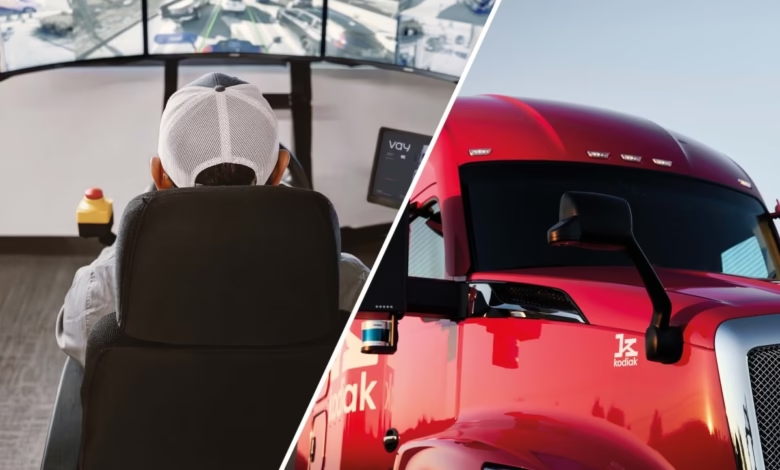Kodiak Integrates Vay’s Remote Tech for Self-Driving Trucks

▼ Summary
– Kodiak Robotics and Vay have partnered to integrate Vay’s remote-driving technology into Kodiak’s self-driving trucks for operational and safety support.
– Kodiak plans to launch commercial driverless deliveries on Texas highways in late 2026, leveraging this partnership for complex scenarios like low-speed navigation.
– Vay’s teleoperations system allows human operators to remotely control Kodiak trucks in specific situations, while Kodiak’s autonomous system maintains primary control and safety limits.
– The collaboration began after Kodiak’s 2022 U.S. Army contract highlighted the need for remote-driving capabilities in unpredictable environments.
– Vay, originally a driverless car-sharing startup, is expanding its teleoperations technology into commercial services, mirroring Amazon’s AWS model for broader industry applications.
Kodiak Robotics has teamed up with Berlin-based Vay to enhance its self-driving truck technology with advanced remote-driving capabilities. The collaboration, announced recently, integrates Vay’s teleoperations system into Kodiak’s autonomous trucks, creating a hybrid approach that combines AI-driven navigation with human oversight for added safety and flexibility.
Since last year, Kodiak’s driverless trucks have been operating in the Permian Basin, delivering materials for Atlas Energy Solutions. The partnership with Vay will play a crucial role as Kodiak prepares for commercial driverless highway operations in Texas by late 2026. Teleoperations, or remote driving, has become a key bridge technology in autonomous vehicle development, supporting everything from delivery robots to robotaxis, and now, long-haul trucks.
Vay’s system allows trained operators to take control of Kodiak’s trucks in specific low-speed situations, such as navigating complex construction zones or responding to unexpected road conditions. The setup includes a steering wheel, screens, and specialized software, enabling seamless remote operation with minimal delay. However, Kodiak’s proprietary “assisted autonomy” system remains in charge, setting boundaries to ensure safety even when a human intervenes.
Andreas Wendel, Kodiak’s CTO, emphasized that the autonomous system handles most driving tasks, while remote operators provide high-level guidance. “It’s not a direct override where you can just flip a truck,” he explained. The technology ensures consistency across different vehicle types, whether a loaded semi, an empty trailer, or a military vehicle, so remote operators experience uniform control regardless of the load.
The need for remote assistance became clear during Kodiak’s work with the U.S. Army, where unpredictable scenarios, like a vehicle needing to hide behind brush, required human judgment. While Kodiak initially developed its own teleoperations solution, it later adopted Vay’s proven system, which had already logged over 10,000 commercial trips in Europe.
Vay, originally a driverless car-sharing startup, has pivoted to offering its teleoperations tech as a B2B service. CEO Thomas von der Ohe likened the strategy to Amazon’s expansion into cloud computing with AWS, envisioning a global remote-driving platform. Meanwhile, Kodiak CEO Don Burnette highlighted how “assisted autonomy” ensures reliable freight delivery in diverse conditions, reinforcing that human oversight remains valuable even as autonomous systems mature.
The partnership underscores a growing trend in the industry: blending AI-driven automation with human expertise to tackle real-world challenges. As Kodiak moves toward commercial deployment, its hybrid approach could set a new standard for safety and adaptability in self-driving trucking.
(Source: TechCrunch)
